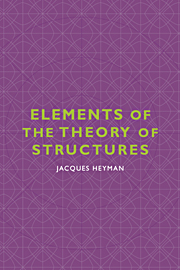Book contents
- Frontmatter
- Contents
- Preface
- 1 The theory of structures
- 2 Virtual work
- 3 Betti, Maxwell, Müller-Breslau, Melchers
- 4 Jettied construction
- 5 Clebsch, Macaulay, Wittrick, Lowe
- 6 The elastica
- 7 Mechanisms of collapse
- 8 The absolute minimum-weight design of frames
- 9 Inverse design of grillages
- 10 The relation between incremental and static plastic collapse
- 11 The bending of a beam of trapezoidal cross-section
- 12 The simple plastic bending of beams
- 13 Leaning walls; domes and fan vaults; the error function ∫e−t2dt
- Bibliography
- Name index
- Subject index
Preface
Published online by Cambridge University Press: 18 December 2009
- Frontmatter
- Contents
- Preface
- 1 The theory of structures
- 2 Virtual work
- 3 Betti, Maxwell, Müller-Breslau, Melchers
- 4 Jettied construction
- 5 Clebsch, Macaulay, Wittrick, Lowe
- 6 The elastica
- 7 Mechanisms of collapse
- 8 The absolute minimum-weight design of frames
- 9 Inverse design of grillages
- 10 The relation between incremental and static plastic collapse
- 11 The bending of a beam of trapezoidal cross-section
- 12 The simple plastic bending of beams
- 13 Leaning walls; domes and fan vaults; the error function ∫e−t2dt
- Bibliography
- Name index
- Subject index
Summary
The theory of structures is one of the oldest branches of engineering. There was early interest in large, indeed ostentatious, buildings, and the design of such buildings needed more than peasant tradition; they were intended to be, and were, spectacular feats, and they required professional advice from acknowledged masters. Names of their designers are known through two or three millenia, and building manuals have survived through the same period. (Man showed also an early interest in waging war, and military engineering is another ancient profession; civil engineers are non-military engineers.)
As might be expected from an ancient discipline, the theory of structures is an especially simple branch of solid mechanics. Only three equations can be written; once they are down on paper, the engineer can in principle solve the whole range of structural problems. Sometimes the equations can be examined individually; sometimes a simple tool, virtual work, can be used to combine them to yield surprising results. In every case, however, it is only the three master equations which come into play. Equations of statics will ensure that a structure is in equilibrium. Geometrical equations will ensure that all parts of a structure fit together before and after deformation, and that the structure rests securely on its foundations. Finally, the properties of the material used to build the structure will enter the equations relating the strain in a member to the applied stress.
These equations were, effectively, known by 1826 (Navier), or more certainly by 1864 (Barré de Saint-Venant).
Information
- Type
- Chapter
- Information
- Elements of the Theory of Structures , pp. xi - xiiPublisher: Cambridge University PressPrint publication year: 1996
